Matchbox 1/72 Swordfish II
|
KIT #: |
PK-112 |
|
PRICE: |
$Cheap from vendors at swap
meets |
|
DECALS: |
Two options |
|
REVIEWER: |
Brian Baker |
|
NOTES: |
Old kit with possibilities. |
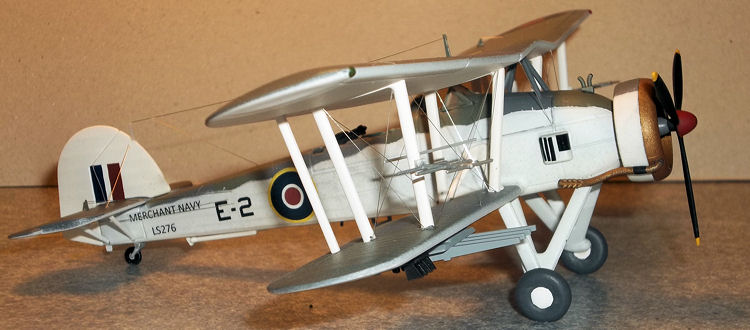
The Fairey Swordfish was one of those flying anachronisms that was expected to
go out of service with only a mediocre career, but, with circumstances and
excellent design, was able to not only outlast its intended successors, but also
to accumulate a war record that few other aircraft of World War II could
achieve.
Entering service in 1936,
the Swordfish went on to serve in both landplane and
floatplane configuration, beginning as a torpedo bomber, progressing to a
general purpose carrier based attack bomber, and winding up doing general patrol
work from land and ship bases.
It may have been the only carrier based biplane to ever
operate search radar from an open cockpit.
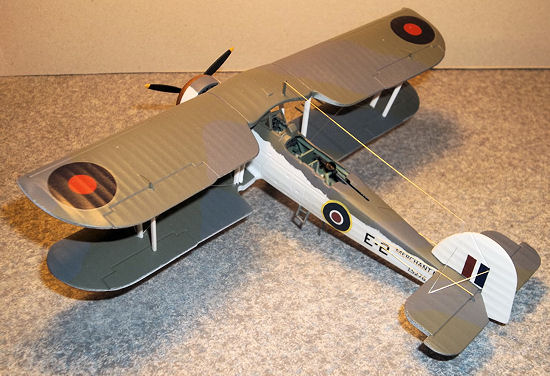 The
basic history of the Swordfish is well known, in its participation in the
attacks on the Bismarck, the highly successful raid on the Italian fleet at
Taranto in 1940, which incidentally, inspired the Japanese to their sneak attack
on the American fleet at Pearl Harbor, and their sacrificial attempt to stop the
German battleships “Scharnhorst” and “Gneisenau”, and the cruiser “Prinz Eugan”
on their way up the English channel in 1942.
Armed at first with bombs and torpedoes, later versions
included rockets in their arsenal, making the aircraft very effective against
shipping and submarines.
In fact, the Swordfish is reputed to have destroyed more
enemy shipping that any other aircraft type during the war.
The
basic history of the Swordfish is well known, in its participation in the
attacks on the Bismarck, the highly successful raid on the Italian fleet at
Taranto in 1940, which incidentally, inspired the Japanese to their sneak attack
on the American fleet at Pearl Harbor, and their sacrificial attempt to stop the
German battleships “Scharnhorst” and “Gneisenau”, and the cruiser “Prinz Eugan”
on their way up the English channel in 1942.
Armed at first with bombs and torpedoes, later versions
included rockets in their arsenal, making the aircraft very effective against
shipping and submarines.
In fact, the Swordfish is reputed to have destroyed more
enemy shipping that any other aircraft type during the war.
The Swordfish appeared in four distinctive
marks, which were as follows:
Mk. I
3 place, 690 hp.
Bristol
Pegasus
IIIM3
engine. Torpedo and bomb armament. Short exhaust stack, and small oil cooler on
the right side of the fuselage.
Mk. II.
3 place,
750 hp.
Bristol
Pegasus XXX (The first few had the Pegasus
IIIM3).
Metal covering under the lower wing, enlarged oil
cooler, longer exhaust stack with flame dampers, and some had radar installed
with external antennas mounted on the outboard struts. Armament was bombs,
torpedo, or rockets. Some also carried
mines, as did later marks.
Mk.
III.
2 Seat.
750 hp. Pegasus XXX.
ASV
radar in belly pod. Armament was bombs and rockets.
Center cockpit was covered over.
Mk. IV.
Canadian trainer version, which carried no armament, but
which had an enclosed canopy due to the extreme Canadian weather conditions. (A
vacuform canopy would be required for this conversion.)
The Matchbox Swordfish kit has been around since 1974, and there are probably
quite a few of them in circulation.
They should be available at model swap meets, and most
serious 1/72 scale modelers have several of them in their stash.
The decals, which were pretty good in 1974, are probably
dried up and flaked away by now, as most of them are approaching 40 years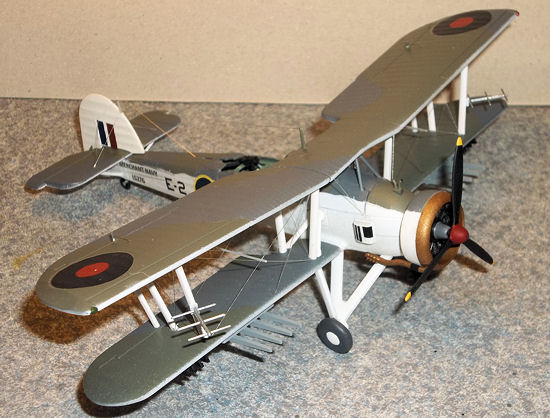 of age.
However, British decals are readily available, so markings should not be
a problem.
of age.
However, British decals are readily available, so markings should not be
a problem.
The instructions
are very basic, but they do show the construction process.
There is no mention of the cockpit discrepancies, and
the three view color box drawings don’t mention this either.
There is a good color chart in several languages.
The box drawings show a scheme for one of the
Taranto
attackers, but they do not mention the extra fuel tank that these aircraft had
in place of the center crew member.
Molded in three different colors, the Matchbox
Swordfish has minimal cockpit detail, simplistic seats, floors, and a very
elementary mounting for a Lewis gun in the rear cockpit.
Details such as sidewall detail, control stick,
instrument panel, and extra equipment must be scratchbuilt.
The fuselage is molded for a Mk.
III,
with the center cockpit cover in place, but this
configuration
is not shown in the color views on the box art.
This means that if you are not building the MK.
III
version, you must trim out the cockpit cover and add a third seat and floor.
The engine, prop, and exhaust are very nicely done,
although the engine is not completely accurate when compared
to the real thing,
and the stack can be shortened for a Mk. I.
The rocket rails, while not ideal, are useable.
I had to scratchbuild the outboard bomb racks, using the
racks from the Airfix kit as a guide.
I had
built this kit many years ago as a Mk.
III,
using the kit decals, but I wanted to do a Mk. II in the nearly all white scheme
used by late war carrier based aircraft,
and since I was planning to build the new Airfix
Swordfish Floatplane, I figured this would be a good comparison.
So I started, and it was certainly a learning
experience. I still have several in my storage cabinet, and will
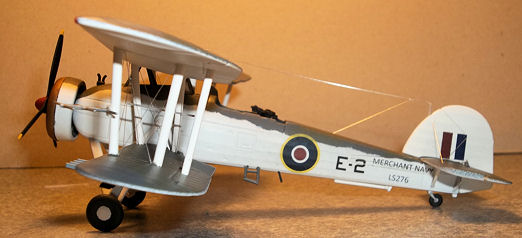 probably
build all of them sometime in the future.
probably
build all of them sometime in the future.
Assembly is pretty straightforward.
I build up the fuselage structure inside the cockpit,
and modified the seats to make them look more realistic.
I added a third seat, and trimmed away the cockpit cover
along the lines on the fuselage.
I added an instrument panel in front, and the RO’s panel
with a
CRT
mounted in it. I used the rear MG mounting, which is marginal, while the Lewis
gun is actually pretty good.
One experimental aspect of this project was the use of Tamiya Liquid Cement for
the first time.
Since Tenax, my glue of choice for many years, has apparently
gone out of production, I needed a replacement, so I used the “Super Thin”
mixture for most of the parts, using the thicker formula on several occasions.
It seemed to work OK (The plane is still together)
although it doesn’t seem to dry as quickly as the Tenax.
Maybe, they’ll start producing Tenax again, but the
Tamiya mixture is adequate.
I
decided to do Swordfish Mk. II, LS276, “E-2” of E Flight, No 836 Squadron, based
on the MV “Amastra”, a converted merchantman escort carrier used by the Royal
Navy for convoy escort during 1943. It has no torpedo racks, but it did have
rocket 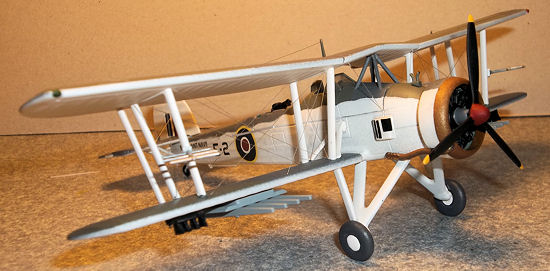 rails
inboard and small bomb racks outboard. The plane had the usual
Extra
Dark
Sea
Grey and Dark Slate Grey upper surfaces, with white undersides. It was an easy
scheme to do, and most of the painting was done before final assembly.
I used a photo from the “In Action” book on the
Swordfish, page 43.
rails
inboard and small bomb racks outboard. The plane had the usual
Extra
Dark
Sea
Grey and Dark Slate Grey upper surfaces, with white undersides. It was an easy
scheme to do, and most of the painting was done before final assembly.
I used a photo from the “In Action” book on the
Swordfish, page 43.
I
used decals from the decal box, and made up the numbers are letters, as this
aircraft was marked with “Merchant Navy” on the fuselage sides, along with an
“E-2” in standard black lettering similar to that used by the
U.S.
Navy.
I didn’t weather the model as I probably should have, but I did rig it
with the usual electronic wire, which I think was quite effective for this
model.
There is a lot of rigging, as all of the control cables are exposed, and
a long LF radio antenna runs from a mast over the wing to a fitting on the
vertical fin. For the radar antenna, I used a radar array from an old Johan
ME-262 night fighter, cutting one of the units to make the third portion.
With the new Airfix kit, this one will probably
languish in the shadows, but it is certainly a buildable kit, and seems to be
accurate in outline.
It requires some extra work, but definitely makes up
into a blob of plastic that resembles a Swordfish, and that, I think, is the
idea.
If you have one or two of these around, don’t throw them away. They
could help you spend a weekend sometime in the future when you’ve got the house
to yourself.
Try one.
You’ll be surprised at the outcome.
Brian Baker
January 2013
If you would like your product reviewed fairly and fairly quickly, please
contact
the editor
or see other details in the
Note to
Contributors.
Back to the Main Page
Back to the Review
Index Page
of age.
However, British decals are readily available, so markings should not be
a problem.
probably
build all of them sometime in the future.
rails
inboard and small bomb racks outboard. The plane had the usual